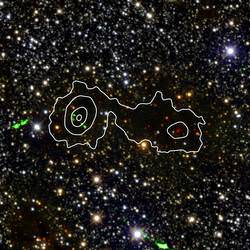
Massive star forming region as seen by ISO. Image credit: ESA. Click to enlarge
Astronomers have used ESA’s Infrared Space Observatory to peer at the biggest stars being born. These stars form from the collapse of enormous clouds of gas, and can shine more than 100,000 times as bright as our own Sun. The images were captured as a bonus, taken while the space observatory was slowly turning from one target to another. A team of astronomers built up a vast web of images comprised from 10,000 of these telescope repositionings, and then identified potential star forming regions from the data.
Scientists have secured their first look at the birth of monstrous stars that shine 100 000 times more brightly than the Sun, thanks to ESA’s Infrared Space Observatory (ISO).
The discovery allows astronomers to begin investigating why only some regions of space promote the growth of these massive stars.
Space is littered with giant clouds of gas. Occasionally, regions within these clouds collapse to form stars. “One of the major questions in the field of study is why do some clouds produce high- and low-mass stars, whilst others form only low-mass stars?” asks Oliver Krause, Max-Planck-Institut fur Astronomie, Heidelberg and Steward Observatory, Arizona.
The conditions necessary to form high-mass stars are difficult to deduce because such stellar monsters form far away and are shrouded behind curtains of dust. Only long wavelengths of infrared radiation can escape from these obscuring cocoons and reveal the low temperature dust cores that mark the sites of star formation. This radiation is exactly what ISO’s ISOPHOT far-infrared camera has collected.
Stephan Birkmann, Oliver Krause and Dietrich Lemke, all of the Max-Planck-Institut f?r Astronomie, Heidelberg, used ISOPHOT’s data to zero-in on two intensely cold and dense cores, each containing enough matter to form at least one massive star. “This opens up a new era for the observations of the early details of high-mass star formation,” says Krause.
The data was collected in the ISOPHOT Serendipity Survey (ISOSS), a clever study pioneered by Lemke. He realised that when ISO was turning from one celestial object to another, valuable observing time was being lost. He organised for ISOPHOT’s far-infrared camera to continuously record during such slews and beam this data to Earth.
During the ISO mission, which lasted for two and a half years during 1995?98, the spacecraft made around 10 000 slews, providing a web of data across the sky for the previously unexplored window of infrared emission at 170 micrometres. This wavelength is 310 times longer than optical radiation and reveals cold dust down to just 10K (-263 degrees Celsius). A catalogue was produced of the cold sites in the survey.
Birkmann and his colleagues investigated this catalogue and found fifty potential places of high-mass stellar birth. A campaign of follow-up observations using ground-based telescopes revealed that object ISOSS J18364-0221 was in fact two cold dense cores that looked suspiciously like those associated with the birth of low-mass stars, but containing much more mass.
The first core is at 16.5 Kelvin (?256.5 degrees Celsius). It contains seventy-five times the mass of the Sun and shows signs of gravitational collapse. The second one is around 12K (?261 degrees Celsius) and contains 280 solar masses. The team are currently studying the other potential sites.
Original Source: ESA Portal
